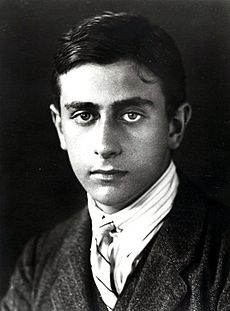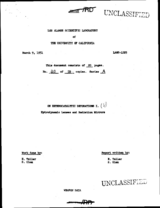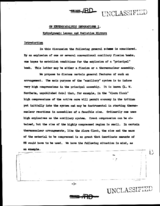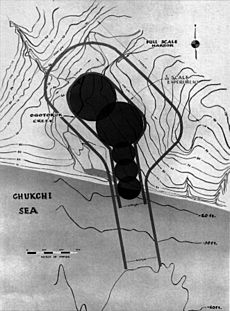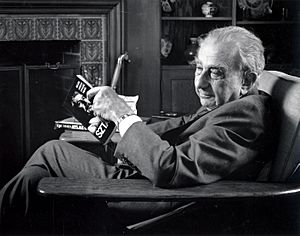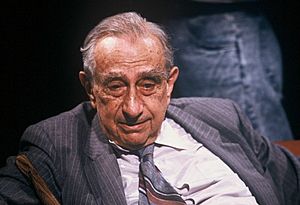Edward Teller facts for kids
Quick facts for kids
Edward Teller
|
|
|---|---|
| Teller Ede | |
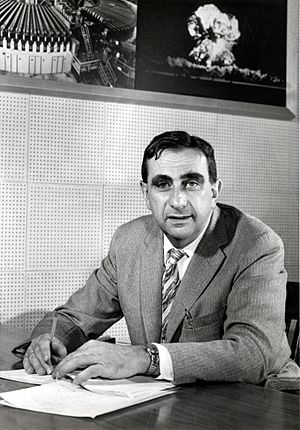
Teller in 1958 as Director of the Lawrence Livermore National Laboratory
|
|
| Born | January 15, 1908 |
| Died | September 9, 2003 (aged 95) Stanford, California, U.S.
|
| Citizenship | Hungary United States (March 6, 1941) |
| Alma mater | University of Karlsruhe (BS) University of Munich University of Leipzig (PhD) |
| Known for |
|
| Spouse(s) | |
| Children | 2 |
| Awards |
|
| Scientific career | |
| Fields | Physics (theoretical) |
| Institutions |
|
| Thesis | Über das Wasserstoffmolekülion (1930) |
| Doctoral advisor | Werner Heisenberg |
| Doctoral students |
|
| Other notable students | Jack Steinberger |
| Signature | |
Edward Teller (born Ede Teller; January 15, 1908 – September 9, 2003) was a Hungarian-American theoretical physicist. He is often called the "father of the hydrogen bomb". This is because he played a key role in developing its design.
Teller was known for his amazing scientific skills. He also had a strong personality. He was born in Hungary in 1908. He moved to the United States in the 1930s. He was one of many talented Hungarian scientists who came to America.
He made many important discoveries in nuclear and molecular physics. He also worked on spectroscopy and surface physics. His work helped us understand how molecules behave. He also helped create the Monte Carlo method. This is a way to solve complex problems using random numbers.
Teller was an early member of the Manhattan Project. This project built the first atomic bomb. He strongly pushed for the creation of nuclear fusion weapons, also known as hydrogen bombs. He later helped start the Lawrence Livermore National Laboratory. He was its director for many years.
After World War II, Teller supported nuclear power. He also believed in having a strong nuclear arsenal. He passed away in Stanford, California, in 2003 at the age of 95.
Edward Teller: A Life in Science
Early Life and Education
Ede Teller was born on January 15, 1908, in Budapest, Austria-Hungary. He came from a Jewish family. His father was a lawyer and his mother was a pianist. Edward was a late talker as a child. But he loved numbers and would do big calculations in his head.
In 1926, Teller left Hungary for Germany. This was partly due to difficult political times. He studied mathematics and chemistry at the University of Karlsruhe. He earned a Bachelor of Science degree there. A visiting professor, Herman Mark, inspired him to switch to physics. Mark showed him how new ideas in physics were changing chemistry.
Teller then studied physics at the University of Munich. In 1928, he had an accident. He fell from a streetcar and lost part of his right foot. He walked with a limp for the rest of his life. He chose to deal with the pain using his willpower.
In 1929, Teller moved to the University of Leipzig. He earned his PhD in physics in 1930. His research was about the hydrogen molecule ion. He became friends with famous physicists like George Gamow and Lev Landau. In 1934, he married Augusta Maria "Mici" Harkanyi.
Moving to America
After Adolf Hitler came to power in Germany in 1933, it became unsafe for Jewish people. Teller left Germany with help from a special committee. He spent time in England and Copenhagen. In 1935, he moved to the United States. He became a physics professor at George Washington University.
At George Washington University, Teller made important discoveries. In 1937, he predicted the Jahn–Teller effect. This effect explains how molecules can change shape. He also helped develop the BET theory. This theory is used to study surfaces in physics and chemistry. Edward and Mici became U.S. citizens in 1941.
When World War II started, Teller wanted to help. He worked with his friend Hans Bethe. They developed a theory about how shock waves travel. This work was useful for studying missiles later on.
Working on the Atomic Bomb
Los Alamos and the "Super"
In 1942, Teller was invited to a meeting about the Manhattan Project. This was a secret Allied effort to build the first atomic bomb. Teller had already been thinking about an even more powerful weapon. This was a nuclear fusion weapon, which he called the "Super." It later became known as the hydrogen bomb.
Teller was very interested in the "Super." He was less excited about just building an atomic bomb. In 1943, he moved to the Los Alamos National Laboratory in New Mexico. This was where the atomic bomb was being designed.
Teller was part of the theoretical team. He wanted to lead the team, but J. Robert Oppenheimer chose Hans Bethe instead. Teller kept pushing his ideas for a fusion weapon. Even though it was not the main focus during the war, he believed it was possible. He made important contributions to the atomic bomb's design. He was the first to suggest a "solid pit" design. This design was later used successfully.
Teller was one of the few scientists who watched the first atomic bomb test. It was called the Trinity nuclear test in July 1945. He later said the flash was like "broad daylight streamed in" to a dark room.
The Decision to Use Atomic Bombs
After the Trinity test, some scientists wanted to show Japan the new weapon. They hoped this would prevent its use on people. Leo Szilard created a petition for this idea. Teller asked Oppenheimer for his advice. Oppenheimer told Teller that politicians in Washington should make such decisions. Because of this, Teller did not sign the petition.
Later, Teller learned that Oppenheimer had actually advised the government. Oppenheimer had supported using the bombs immediately. This made Teller feel that Oppenheimer had been dishonest with him. Their friendship began to weaken after this.
Developing the Hydrogen Bomb
After the war, Teller left Los Alamos. He became a professor at the University of Chicago. In April 1946, he attended a conference about the "Super." Scientists discussed how to build a hydrogen bomb. At first, they thought it would be very difficult. Teller, however, remained hopeful. He wrote an optimistic report. He said a hydrogen bomb was possible and encouraged more work.
A New Design Emerges
In 1949, the Soviet Union tested its first atomic bomb. This led President Harry S. Truman to start a program to build a hydrogen bomb. Teller returned to Los Alamos in 1950 to work on this project. Many other scientists, including Enrico Fermi and Oppenheimer, thought the H-bomb was too hard to build.
In 1950, calculations showed that Teller's early ideas for the H-bomb wouldn't work. But in 1951, Teller and Stanislaw Ulam had a major breakthrough. They came up with a new design for a practical H-bomb. This became known as the Teller–Ulam design.
The exact details of their discovery are still secret. But it involved separating the atomic and fusion parts of the bomb. It also used X-rays from the atomic bomb to compress the fusion fuel. This compression was key to making the fusion reaction work.
This new design changed everything. Scientists who had doubted the H-bomb now believed it was possible. Even Oppenheimer called the idea "technically sweet."

Teller was not chosen to lead the H-bomb project. In 1952, he left Los Alamos. He joined the new Lawrence Livermore National Laboratory. After the first successful test of a Teller–Ulam weapon in 1952, Teller became known as the "father of the hydrogen bomb."
Some of his colleagues were annoyed that he took so much credit. Teller later wrote an article saying many people contributed. But in his memoirs, he claimed full credit for the invention.
After the War: Nuclear Energy and Defense
After the Oppenheimer controversy, many scientists avoided Teller. But he remained popular with the U.S. government and military. He continued to support nuclear energy and a strong nuclear arsenal. He also helped create safety rules for nuclear reactors. He even helped design reactors that could not have a nuclear meltdown. These reactors are used in hospitals and universities worldwide.
Teller believed the U.S. needed to spend more on defense. He thought this was important to counter the Soviet Union. He was director of the Lawrence Livermore National Laboratory from 1958 to 1960. He also taught physics at the University of California, Berkeley.
Teller strongly argued against a proposed test ban treaty. He believed continued nuclear testing was necessary. He retired in 1975. He continued to visit his home country of Hungary after communism ended there.
Peaceful Uses of Nuclear Explosions
Teller was a big supporter of using nuclear explosions for peaceful purposes. This was part of a U.S. program called Operation Plowshare. One idea was to use a hydrogen bomb to dig a deep-water harbor in Alaska. This was called Project Chariot. The idea was to help ship resources like coal and oil.
However, this project faced many problems. Scientists worried about safety for wildlife and local people. It also turned out the harbor would be frozen for most of the year. The project was stopped in 1962.
Another idea was to use nuclear explosions to get oil from tar sands in Canada. This plan was approved by the local government. But the Canadian Prime Minister at the time rejected it.
Teller also suggested using nuclear bombs to stop powerful hurricanes. He thought explosions could create many small hurricanes instead of one big, dangerous one.
Advising on Nuclear Technology
For about 20 years, Teller advised Israel on nuclear matters. He shared his knowledge about nuclear reactors and energy. He visited Israel many times between 1964 and 1967. He lectured at Tel Aviv University and advised Israeli leaders.
Teller also strongly supported nuclear energy after the Three Mile Island accident in 1979. He had a heart attack soon after. He joked that he was "the only victim of Three-Mile Island" because he worked so hard to defend nuclear power.
Protecting Earth from Asteroids
After a comet hit Jupiter in 1994, Teller had another idea. He suggested that U.S. and Russian scientists work together. They could design a huge nuclear device. This device could be used to protect Earth from dangerous asteroids. He thought it could vaporize a small asteroid or change the path of a very large one.
Later Life and Legacy
Edward Teller passed away in Stanford, California, on September 9, 2003. He was 95 years old. He had suffered a stroke two days before.
Teller's strong support for nuclear weapons made him a famous figure. Some people even thought he inspired the character of Dr. Strangelove in a movie. But Teller did not like this idea.
Despite some disagreements, Teller received many awards for his work. These include the National Medal of Science and the Presidential Medal of Freedom. An asteroid, 5006 Teller, is also named after him. His final paper, published after his death, suggested building a new type of nuclear reactor.
Images for kids
-
Teller's ID badge photo from Los Alamos
-
Physicists at a Manhattan District-sponsored colloquium at Los Alamos on the Super in April 1946. In the front row are (left to right) Norris Bradbury, John Manley, Enrico Fermi and J. M. B. Kellogg. Robert Oppenheimer, in dark coat, is behind Manley; to Oppenheimer's left is Richard Feynman. The Army officer on the left is Colonel Oliver Haywood.
-
Teller became a major lobbying force of the Strategic Defense Initiative to President Ronald Reagan in the 1980s.
See also
 In Spanish: Edward Teller para niños
In Spanish: Edward Teller para niños


